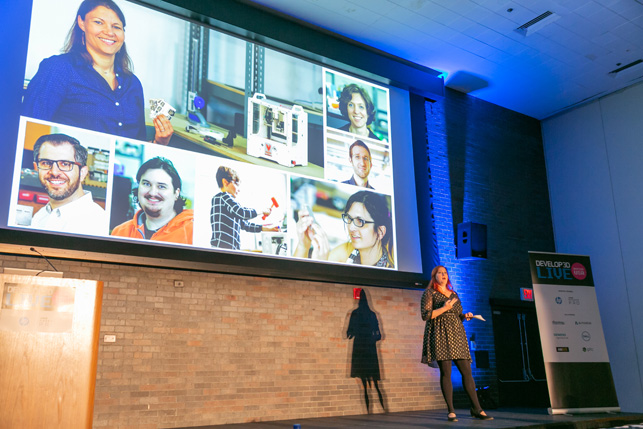
Danielle Applestone of Daughters of Rosie outlines plans to train women to fill the manufacturing skills gap
Technology is king at DEVELOP3D Live, so it was fitting that two brand new technologies that seek to revolutionise not only the design of components, but also their fabrication got their first public airing in Boston this month at our third annual US event.
With the rise of additive manufacturing, CAD systems have been able to change the way they interface with output. Topology optimisation software from the likes of Frustrum and nTopology have been available to assist in the simulation and lightweighting of designs intended for 3D printing.
Both Frustrum and nTopology used DEVELOP3D Live USA to launch brand new – and seriously amazing – design kernels for generative functional design.
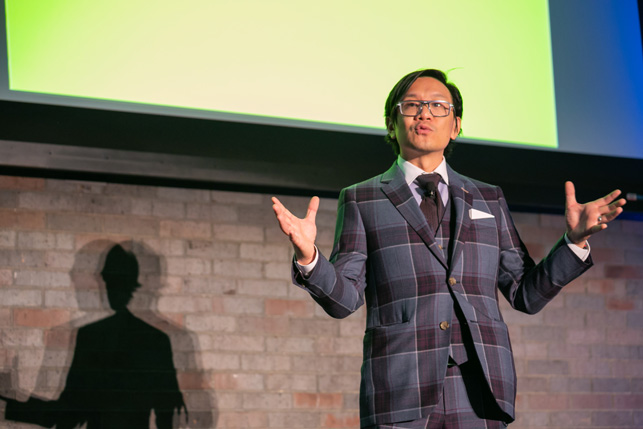
MC for the day and the Mighty Dynamo himself, Chris Cheung
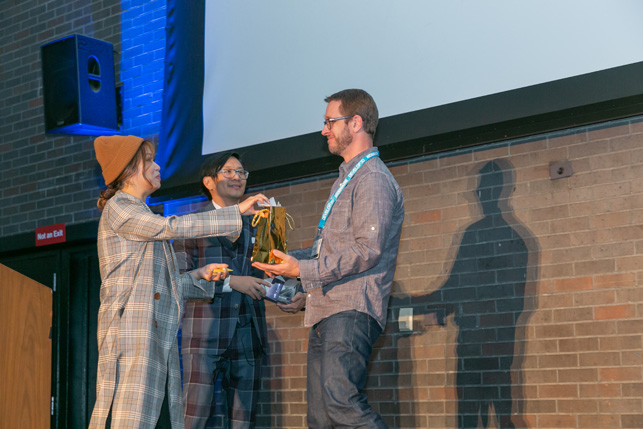
Keynote speaker Ti Chang of Crave presents a prize
Frustum’s technology is called TrueSolid and enables adaptive lattice blending, the likes of which you have never seen before. NTopology’s new implicit modelling kernel, meanwhile, can take bulk material properties and batch process designs to produce perfect manufacturable deliverables.
Blake Courter of nTopology (and formerly of Stratasys, SpaceClaim and PTC), spoke about the advantages of AM in its ability to produce parts of unlimited geometric complexity, working at the meso scale.
Building on the AM theme, our dedicated Additive Manufacturing track (see below) was a tour de force, showcasing the very latest in metals printing and optimising designs for manufacture.
Our morning keynotes featured two female designers, both of whom are seeking to drive much-needed changes in the industry. Ti Chang, co-founder and vice president of design at Crave, explained how her firm was fighting existing social constructs and gendered expectations in sex toy design, moving away from the phallic to create products so beautiful that they double as jewellery.
Meanwhile, Danielle Applestone, CEO and founder of Daughters of Rosie (named for the iconic WWII recruitment poster depicting ‘Rosie the Riveter’), is on a mission to fill the 600,000-plus open positions in US manufacturing. Her strategy is to engage with manufacturing firms, understand their requirements and then create bespoke training programmes to get women into those unfilled jobs.
There is no time to waste. Looking forward, it’s predicted that there will be 2 million job vacancies by 2025, so Daughters of Rosie is urging manufacturers to look ahead and widen the net to include women who are looking for both full-time and part-time roles in manufacturing, but who may not have studied or previously considered working in the field.
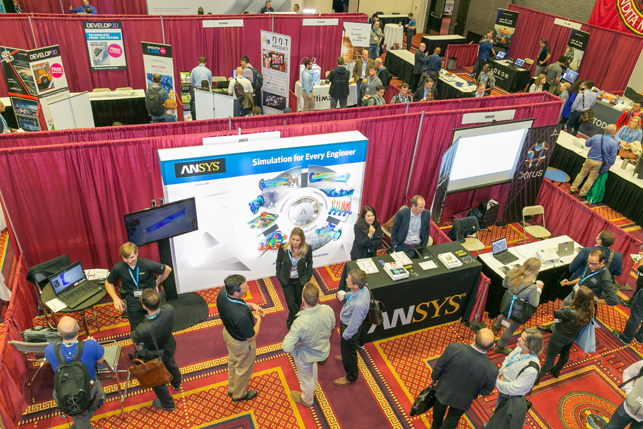
Attendees take the opportunity to get hands-on with new technologies
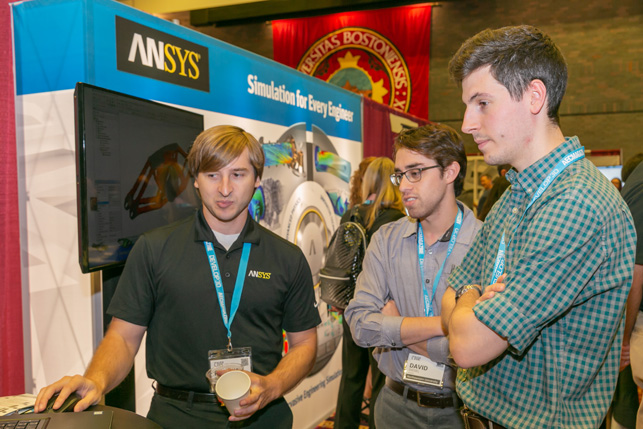
Plenty of demos available for those wanting to take a deep dive
Inform, educate, entertain
There were also presentations from the core industry CAD firms. SolidWorks, Autodesk, PTC, Onshape and Siemens presented an array of innovative uses for new design technology, such as electric bikes, generatively designed and optimised skateboard trucks, schematic electrics in Solid Edge, simulation for manufacture in Creo and Onshape’s new enterprise features for seamless collaborative working.
To finish the day, we had Fictiv’s Mike Geyer examining supply chains and questioning how we use 50-year old technology to run multi-billion-dollar businesses and urging firms start thinking in terms of supply networks and ecosystems, in order to overcome the linear bottlenecks that hamper innovation and time to market.
Jeremy Luchini was a logical follow-on from last year’s keynote speaker Mouse McCoy, insofar as he is also designing and manufacturing his own supercars using VR. He only makes physical prototypes when that stage becomes absolutely necessary and uses 5-axis machining on a massive scale (26m x 6m x 3m) to cut out the body shape. Absolutely amazing stuff.
DON’T MISS OUT ON THE ACTION: Videos of the presentations will be available shortly on youtube.com/Develop3dMagazine. Follow @DEVELOP3D on Twitter to be alerted when they are live and free for viewing.And be sure to add 17 April to your diaries for DEVELOP3D Live at Sheffield University, UK.

Dr Masha Petrova details AM initiatives at Ansys
Additive track @ DEVELOP3D LIVE USA 2018
Aiming to cover the entire breadth of the fastchanging additive manufacturing industry in one day, the stage at D3D LIVE USA was a constant hive of activity, featuring the cutting edge, the future facing, the game changing and the brutally honest.
What was instantly noticeable was that a 3D printer is nothing without the ecosystem that surrounds it. First up on the stage was a brief look at what an endto-end ecosystem can look like – in this case, Dassault Systèmes’ expansive 3D Experience platform – and how many different factors are needed to create functional, repeatable parts.
It became clear early on that verification is fast becoming key as AM industrialises and scales. At the front end, Ansys (above) brings its own considerable knowledge of simulation tools to complex AM builds, helping to pre-empt disasters, rebuilds and wasted time and money before any 3D printer is even switched on.
However good the design, the simulation, the 3D printer or the materials used, things can still go wrong. Volume Graphics’ software for analysing CT scan data of 3D-printed parts was eye-opening for many in the audience as they discovered the damage tiny discrepancies in the materials and powder can cause.
Running through the process end-to-end was the need to protect this overall digital workflow and the supply chain, with Identify3D giving an insight into the problems that arise through distributed manufacturing and datasharing across platforms, machines and locations.
Jaw-dropping new 3D printing technology was showcased by Velo3D (below), which can print metal parts at teetering gradients without supports; and also by Digital Alloys, which uses Joule printing to quickly produce near net shape parts in metals that are costly to machine from billet.
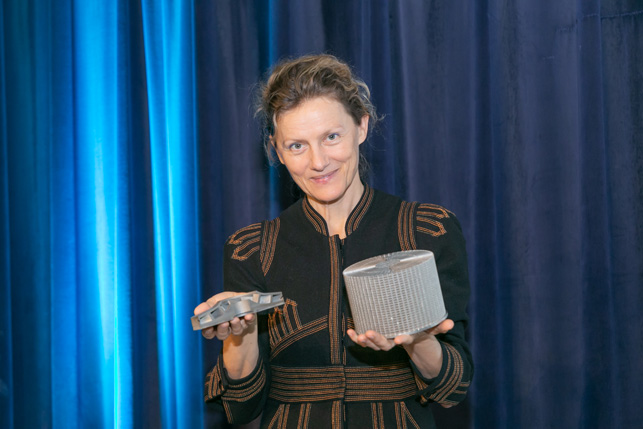
Tatjana Dzambazova of Velo3D shows off parts from Velo3D’s process
Both technologies are likely to revolutionise the metals 3D printing sector beyond the old adage of ‘adding more lasers’ and could have many companies from industries such as aerospace, medical and automotive beating a path to their doors.
Evan Kuester explained how 3D printing has enabled him to design better custom prosthetics to enable something like a prosthetic limb to be designed more like a beautiful piece of jewellery or a child’s favourite toy, bringing human emotion into a product.
Most interesting of all was David Benhaim’s vision of a future where the tools of product designers are instantly customisable; for example, a software designer who simply writes their own new snippet of code to build or modify a product. In his work as CTO of Markforged, Benhaim has begun to implement some elements of this – and believes much more will be possible in the future.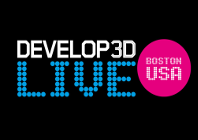
We look back at the highlights from our third annual US event
Default






